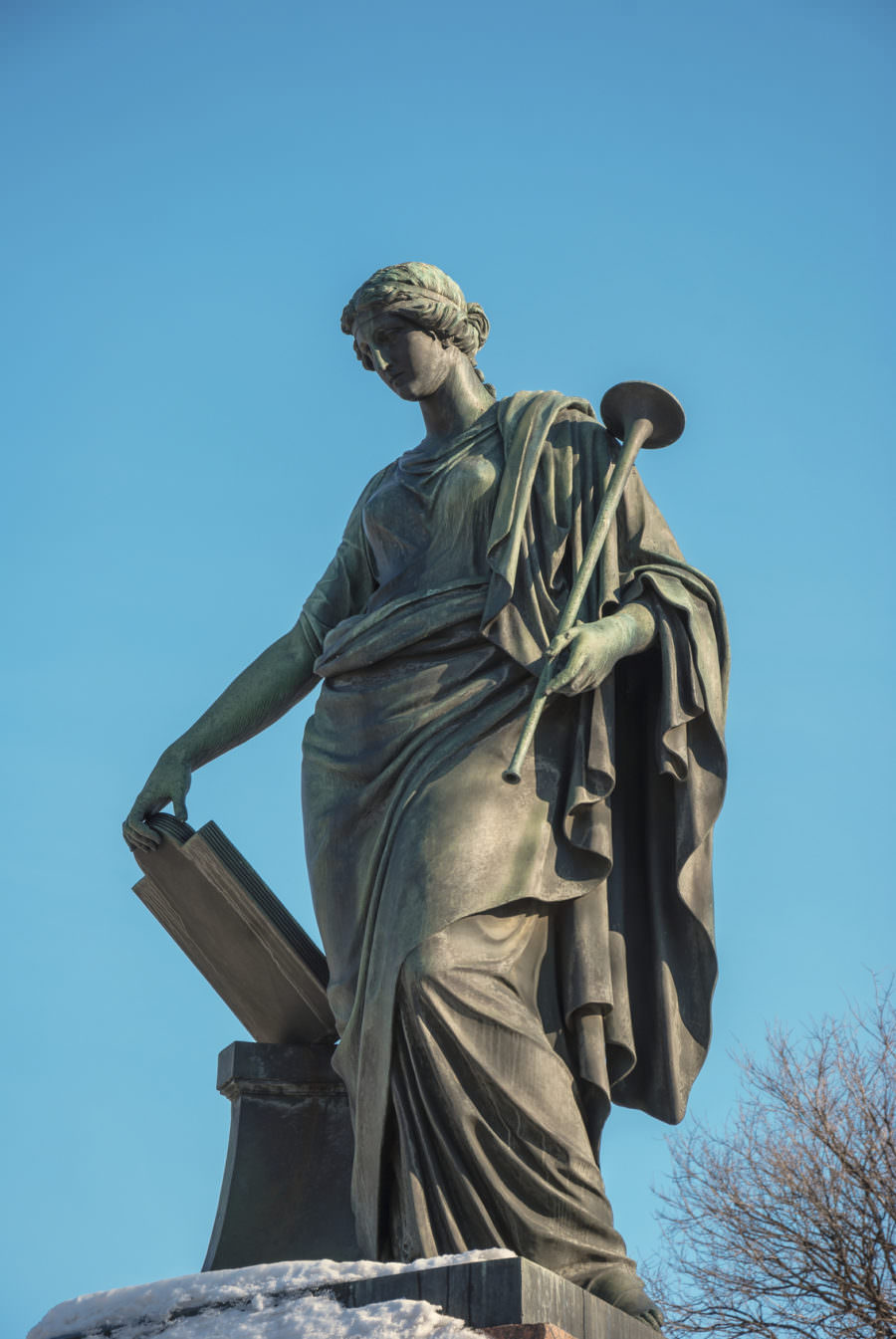

Franzoni also eliminated the raised mirror. Her more natural posture, with her left foot resting on the edge of the car, diverges from the frontal, emblematic version Latrobe sketched. Evidence suggests that she previously held a quill pen. Franzoni contrasts the articulated feathered wings of the chariot with the smooth surfaces of classically styled cascading drapery and Clio’s bare arm, poised in the act of writing in an open book (fig. Gracefully poised in a sinuous S-curve, a standing Clio looks to her right as her body faces left, moving forward with the winged chariot that travels from west to east.
Clio muse of history statue figurine license#
The architect clearly gave the sculptor artistic license to create the marble, as Franzoni’s neoclassical grouping is more sculptural and animated than the architect’s version (fig. Latrobe hired Italian sculptor Franzoni (the younger brother of Giuseppe, who had sculpted the high relief figures on the destroyed frieze), to execute his design. United States Congress, Courtesy of the Architect of the Capitol photography by Chuck Badal Latrobe may have been inspired by Second Empire mantel clocks, which also feature Roman-style chariots with clock face wheels and are often combined with mythological figures however, Latrobe’s creative solution of literally wedding time with history on a monumental scale appears to be unprecedented. A clock face with Roman numerals replaces the wheel of the double-winged chariot that moves from east to west. In his sketch, Latrobe shows Clio seated with what appears to be a book in her lap, a pen in her right hand, and a mirror in her raised left hand, an attribute that is more commonly associated with figures of Prudence or Truth. Collection of the Prints and Photographs Division, Library of Congress Ink and watercolor on paper, 19 1/16 x 27 ¾ in. Benjamin Henry Latrobe, House Chamber Details, 1815. Perhaps the recent devastation of the Capitol in the War of 1812 prompted Latrobe to see the work of Congress from a historical perspective. Across the chamber, a sculptural group faces her that is thematically similar to the one that had been destroyed by fire.

Above the north door, positioned between two Corinthian columns, he placed Clio in a Roman triumphal chariot. He also rethought its sculptural program, creating two focal points facing one another, now that the space was shorter and wider. In designing the new Hall of the House of Representatives, Latrobe significantly altered the room shape, transforming it into a semicircular auditorium. In the original hippodrome-like chamber designed by Latrobe and completed in 1807, the architect had specified a celebratory sculptural allegorical figure of Liberty seated above the Speaker’s chair, capped by a rising eagle on the entablature, with four recumbent figures in high relief representing Agriculture, Art, Science, and Commerce carved into the opposite frieze. The concept for the Car of History derives from a drawing that architect Benjamin Henry Latrobe (1764–1820) made in 1815, as he reenvisioned the Hall of the House of Representatives following its destruction by the British the previous year (fig. Courtesy Architect of the Capitol photography by Thomas Hatzenbuhler View of Statuary Hall looking northeast, 2021. One wonders what this silent witness observed on January 6 and how those events will ultimately be remembered. For those of us who are not legislators but who visit or work in the Capitol, it is a sentinel and touchstone.

It is a persistent reminder to legislators to be cognizant of their words and deeds and that they are accountable. 1 Situated above the entrance to the old Hall of the House of Representatives, now Statuary Hall, and opposite the original Speaker’s rostrum, it features Clio, the Greek Muse of History, recording events as time sweeps forward, literally and figuratively (fig. The eloquent and functional Car of History (1819) by sculptor Carlo Franzoni (1789–1819) and clockmaker Simon Willard (1753–1848) transcends the circumstances of its commission and is as relevant today as it was two centuries ago. The breach of the Capitol on January 6, 2021, has not only reframed my view of this symbolic building’s relationship to the public, it has also prompted me to reengage with one of its oldest and most evocative works of art.


 0 kommentar(er)
0 kommentar(er)
